A selection of the best varieties of sweet peppers with descriptions
The yield of sweet pepper depends on the choice of variety. Some bell peppers are suitable for growing in regions with a cool and changeable climate (in the Urals or Siberia); others take root only in the warm Moscow region.
It is important to choose a variety based on the characteristics of the area, taking into account the duration of summer, the amount of precipitation and winds when choosing. Let's take a closer look at the popular varieties and hybrids of pepper with photos and descriptions for different regions.
Description and characteristics of sweet pepper
Bell peppers are loved by gardeners all over the world. His valued for its attractive appearance and bright color, juicy taste and the ability to prepare hundreds of different dishes from vegetables.
The pulp contains amino acids and dietary fiber, vitamin C and elements necessary to maintain immunity - magnesium, sodium, iron. Sweet pepper serves as the basis for many dietary and healthy dishes.
Features of cultivation
To obtain a rich harvest, peppers are grown in seedlings.. Seedlings are prepared 3-4 weeks before planting in open ground, seeds, soil and seedling container are disinfected.
The vegetable is planted in sunny and spacious beds, which are dug up and fertilized with manure before planting. The best predecessors for sweet peppers are legumes, greens, and cabbage. It is not recommended to plant it after potatoes or tomatoes.
Important! Pepper takes root in loamy and sandy soils with neutral acidity.Land with high acidity is limed before planting - a mixture of dry wood ash and lime is added. This composition saturates the soil with useful elements.
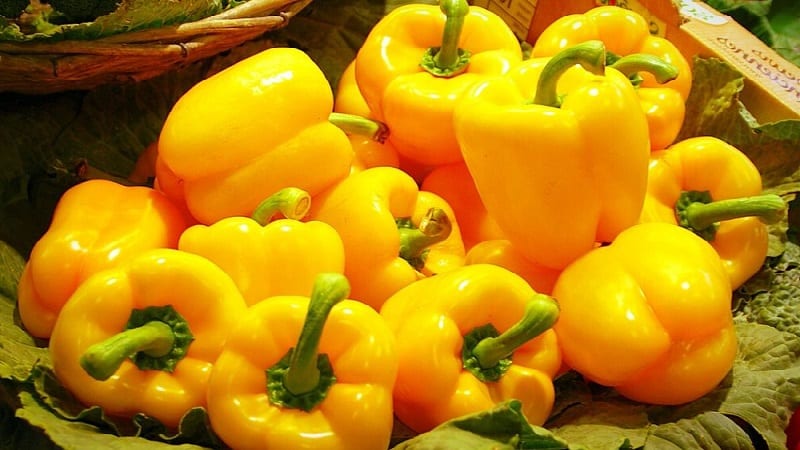
The best varieties and hybrids of bell peppers
To know the best varieties of sweet peppers and seeds suitable for a particular region, let’s look at which representatives are considered the most delicious and high-yielding.
Early ripening
Such varieties Suitable for regions with short and cool summers. Vegetables ripen in 2.5-3 months, rarely get sick and are rarely attacked by insect pests:
- Viking variety ripens in 90-95 days from the moment the first shoots appear. It is cold-resistant and immune to sudden climate changes. The leaves are dark green and medium in size. The shape of the fruit is cone-shaped, slightly elongated, red in color. Average weight - 200 g, wall thickness - up to 8 mm. Viking is suitable for long-distance transportation and can be stored for up to 2-3 months.
-
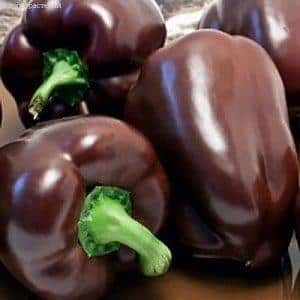 Variety "Sweet Chocolate"
Variety "Sweet Chocolate"Variety Sweet chocolate famous for the unusual color of its fruits. The peppers are burgundy-brown, cuboid in shape. The weight of the vegetable varies from 70 to 90 g, the wall thickness is 6 mm. The pulp is dense and juicy, with a high sugar content. Sweet chocolate matures in 90-105 days. The variety is universal in application, used for fresh consumption, canning and pickling.
- Yellow bell. The weight of large yellow fruits is 200-300 g. The variety shows the best yield in greenhouses or greenhouses. Planted by seedlings. The wall thickness is 7-8 mm, so it is in demand when grown for sale. The surface is glossy and bright. Resistant to viral and fungal diseases.
- Variety Giant Dutch. The height of the plant is about 70 cm, the shoots are powerful.The fruits set quickly, the weight of one is about 100 g, the wall thickness is 6 mm. The color is uniform, rich red. The Dutch giant has juicy and nutritious pulp. Suitable for industrial cultivation.
Mid-season
Mid-season types of pepper preferred by gardeners from central Russia. Plants are easy to care for and have stable yields:
- California miracle. The popular sweet pepper ripens in 115-125 days from germination. Suitable for growing in open ground, greenhouses or greenhouses. It is resistant to diseases. The fruits are cube-shaped, rich red in color. Average weight is 100 g, the pulp is sugary and tender.
-
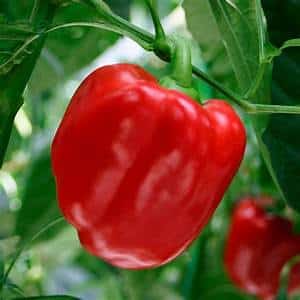 Pepper "Funtik"
Pepper "Funtik"Merchant. Miniature standard bushes reach a height of 60 cm and produce a harvest 4 months after planting. The fruits are cone-shaped, drooping. Weight varies from 100 to 140 g, wall thickness is 7 mm. The peel is elastic, red, glossy. Productivity is stable, from 1 sq. m summer residents collect about 5 kg. Vegetables are used to prepare salads and side dishes, stuffed or baked dishes.
- Funtik. Ripening period is 110-120 days. Planted with seeds in open ground or by seedlings. Funtik quickly adapts to external climatic conditions and is unpretentious in care. Fruit weight is 150-200 g, wall thickness is 9 mm. The peppers set together and the fruiting period is extended.
Important! The ripeness of bell peppers is determined by the elasticity of the peel, dry stalk and brightness of color. For long-term storage, the harvest is placed in wooden boxes, covered with newspaper on top and stored in a dry and dark cellar or basement. Peppers with thick walls are stored there for up to 3-4 months. Some gardeners chop the peppers into strips and freeze them in the freezer.
Late ripening
Late-ripening varieties and hybrids of bell pepper chosen for cultivation in the southern regions. Vegetables have a very juicy taste and bright aroma:
-
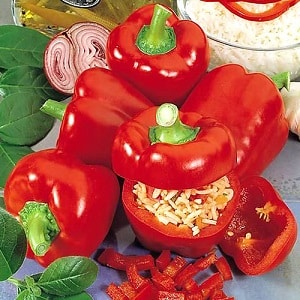 Pepper "Ruby"
Pepper "Ruby"Ruby. Ruby sweet peppers ripen in 130-140 days. The plant is miniature, about 45 cm high. The fruits are flattened, round, each weight is about 130 g. The color is dark red, the surface is slightly ribbed. Productivity is about 4 kg per 1 sq. m. It is recommended to use the variety for preparing winter preparations or freezing.
- Bogatyr. The ripening period ranges from 120 to 140 days, it is recommended to plant seedlings. The bushes are powerful, spreading, with a developed root system. Cone-shaped peppers weigh about 160 g, have a bright red color and walls 7 mm thick. The variety is planted in greenhouses and open beds. Bogatyr is resistant to viral and infectious diseases.
- Chord. The hybrid matures in 140-150 days. The fruits are red, cone-shaped. The plant is medium-sized and does not require special agrotechnical rules for care. Weight - about 130 g, the pulp is sugary and juicy. It is resistant to prolonged heat and high humidity. Universal in use.
Hybrids
Hybrids valued for resistance to major crop diseases — late blight, tobacco mosaic, root rot. They are unpretentious in care and are rarely affected by pests:
-
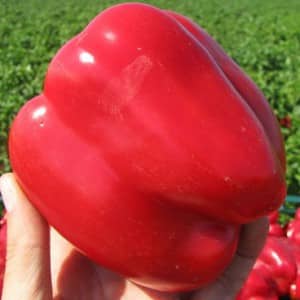 Pepper "Hercules"
Pepper "Hercules"Pepper Hercules. Ripens in 70-75 days, tall bushes, medium-sized leaves. The fruits are smooth, weighing 250-300 g. The color is dark red, the yield is 3 kg per 1 sq. m.
- Janika. Ripening period is 80-90 days. The hybrid is planted both in greenhouses and in open ground. The weight of the pepper is about 150 g, the color is bright red. The length of the vegetable is 12 cm, the wall thickness is 8 mm.Suitable for sale and long distance transportation.
- Pharaoh. Large fruits are distinguished by juicy and sweet pulp, high content of vitamins and minerals. The pepper is large, weighing about 200 g. The walls are 8 mm, the color is yellow or pale red. The hybrid rarely gets sick and is characterized by keeping quality.
For greenhouses
Greenhouse varieties are planted in greenhouses or polycarbonate structures. They have early and medium ripening periods, are distinguished by large-fruited:
-
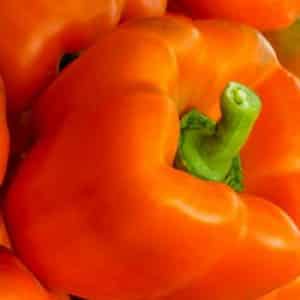 Pepper "Magno"
Pepper "Magno"Aden. Pepper is resistant to heat and heavy rains, and has an extended fruiting period. The fruits are heavy, average weight - 200 g. Red color, wall thickness - 9 mm. The flesh is crispy and sweet.
- Siberian prince ripens in 100-110 days. The plant is semi-spreading, up to 140 cm in height. The fruits are oblong, the weight of one varies from 90 to 130 g. The taste is sweet. Vegetables are used for stuffing, frying, stewing.
- Magno. The medium-sized hybrid rarely gets sick and does not require much time or effort to care for. The appetizing fruits are orange in color and have a glossy, dense skin. Ripens on average in 100 days, vegetables grow weighing 200 g, and are distinguished by keeping quality.
Interesting! Along with sweet varieties, cubeba pepper is popular. It looks similar to black peppercorns, but has a richer minty flavor. Used in cooking and medicine.
For open ground
Cold-resistant and unpretentious varieties and hybrids are planted in open ground. Gardeners use the seedling method. Popular varieties in this category:
-
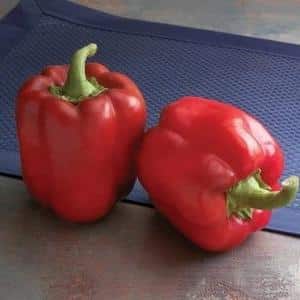 Hybrid "Mammoth"
Hybrid "Mammoth"Sweet banana. The harvest ripens in 100-110 days from the moment the first shoots appear. The shape is elongated, drooping. The weight of the vegetable is about 120 g, the peel is 7 mm. The color is red, the surface is slightly ribbed.The taste is high, the flesh is tender, suitable for fresh consumption and heat treatment.
- Gladiator. The plant is compact, up to 50 cm in height. The fruits set together and quickly, the weight of one is on average 200 g. The shape is truncated, the flesh is tender, the color is rich yellow. Gladiator is grown for personal use and for sale. Thanks to the thick walls, the harvest can be stored for up to three months.
- Hybrid Mammoth ripens in 100 days, is distinguished by its versatility in use and high taste. Fruit weight is 250-300 g, the peel is glossy, bright yellow. The wall thickness is 3 mm, so it is recommended to process the crop immediately after harvesting.
For Siberia
Siberia has short summers, cool weather, and a long absence of sunlight. The following varieties are recommended for cultivation in this region::
-
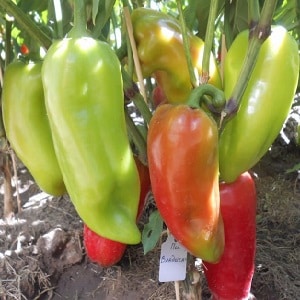 Pepper "Vladyka"
Pepper "Vladyka"Tusk. Mid-season. They are planted both in open beds and in greenhouse conditions. Cold-resistant, rarely gets sick. The fruits are large and red. Average weight - 120-150 g, wall thickness - 8 mm. Suitable for pickling, preparing lecho and other winter preparations.
- Lord. An early ripening variety produces a harvest in 90 days. Fruiting is extended, 20-30 fruits are harvested from one plant. The color is bright red, weight - 200 g. It is distinguished by its shelf life and high commercial qualities.
- Lesya. Sweet peppers ripen in 110 days; it is recommended to plant them in a greenhouse. The plant is standard, with short shoots. The fruits are medium-sized, weighing 100-120 g. The surface is smooth and glossy, the flesh is juicy and sweet, with a rich aroma.
For the Moscow region
The Moscow region is characterized as a region with long summers, loose and fertile soil, and favorable conditions for growing bell peppers. Suitable varieties and hybrids:
-
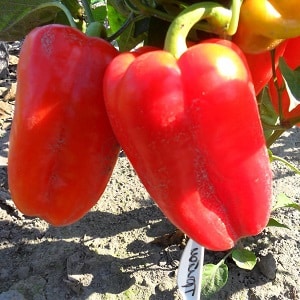 Pepper "Triton"
Pepper "Triton"Stanley. A mid-early hybrid with thick walls is grown for sale; the harvest is distinguished by high commercial qualities and juicy pulp. Ripens in 110 days, the bushes are tall, up to 1.5 m in length. The fruits are drooping, weighing up to 150 g, glossy red in color. Wall thickness - 10 mm, taste sweet. It is resistant to Fusarium wilt and insect pests.
- Triton. The cone-shaped Triton variety is suitable for growing in open beds. It is easy to care for and has a pleasant taste and aroma. Wall thickness - 7 mm, average weight - 140 g. It comes in red, yellow and orange.
- Gold format is a pepper with fast germination and stable yield. 10-15 fruits are collected from one plant. The peppers are large, weighing up to 400 g, golden-honey in color. The variety is universal in use and can be stored for a long time.
Read also:
The best early varieties of pepper for open ground and greenhouses
The best hybrids and varieties of peppers for polycarbonate greenhouses
Tips and recommendations from experienced gardeners for growing
Even well-chosen seeds of the best varieties of sweet peppers do not guarantee a good harvest. It is required to follow the rules of planting and growing. Experienced summer residents recommend:
- Keep the beds clean - regularly loosen the soil and remove weeds. Loosening makes the soil lighter and more nutritious and saturates the roots with oxygen. Weeds interfere with the healthy development of the plant, so they are removed once a week.
- Water the peppers in the morning or evening. This helps avoid sunburn and water evaporation. Use clean water at room temperature.
- In regions with a cool climate, after planting seedlings in the garden, cover the bushes with polyethylene.It protects from possible frosts, winds and rains. The shelter is removed after a week.
- To improve the taste of fruits, use organic and mineral fertilizers - superphosphate, wood ash, Bordeaux mixture, urea, manure.
- To protect against diseases and pests, spray plants with a solution of copper sulfate 2-3 times per season.
Conclusion
To choose the right variety, it is recommended to study reviews from gardeners about a particular vegetable, pay attention to its name, properties and photographs.
For Siberia, early ripening peppers with immunity to diseases and harsh climates are chosen; in the Moscow region, more demanding and demanding varieties are grown. Bell peppers are planted in spacious and sunny beds using the seedling method. Sweet peppers, unlike hot peppers, need mineral and organic fertilizers and regular watering.